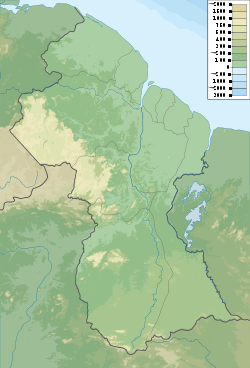Wei-Assipu-tepui
| Wei-Assipu-tepui | |
|---|---|
 Landsat image of the southern part of the Eastern Tepuis chain. The two large central plateaus are Kukenán-tepui (left) and Roraima-tepui. Wei-Assipu-tepui is the small peak to the northeast of Roraima. Also visible in the top left of the frame is Yuruaní-tepui. | |
| Elevation | 2,400 m (7,900 ft)[1] |
| Location | |
 Wei-Assipu-tepui Location in Guyana | |
| Location | Roraima, Brazil / Cuyuni-Mazaruni, Guyana |
| Coordinates | 05°13′08″N 60°42′18″W / 5.21889°N 60.70500°WCoordinates: 05°13′08″N 60°42′18″W / 5.21889°N 60.70500°W |
Wei-Assipu-tepui, also known as Little Roraima or Roraimita,[2] is a minor tepui of the Eastern Tepuis chain. It lies just off the northeastern flank of Roraima-tepui, directly on the border between Brazil and Guyana, and very close to the tripoint with Venezuela.[3] The mountain is known for its extensive cave systems, with one extending for over a kilometre.[3]
Wei-Assipu-tepui has a maximum elevation of around 2,400 metres (7,870 ft).[1] Its summit plateau is highly dissected and generally inclined south-southwest (towards the Brazilian side).[3] The rocky summit is partially forested, with flowering plants of the genus Bonnetia featuring prominently.[4] It also hosts a number of carnivorous plants, including Heliamphora glabra, Heliamphora nutans, and the natural hybrid between the two.[2] The various rock cavities of Wei-Assipu-tepui are home to nesting colonies of White-collared Swifts (Streptoprocne zonaris) and Oilbirds (Steatornis caripensis).[3] For the latter species, Wei-Assipu-tepui is the easternmost recorded locality in mainland South America, and the first known nesting site in Brazil.[3] The mountain's summit supports a greater variety of herpetofauna than the less vegetated plateaus of nearby Roraima-tepui, Kukenán-tepui, Yuruaní-tepui, and Ilú-tepui.[1] Day temperatures of 17 °C have been recorded on the summit plateau, falling to 12 °C overnight, with slightly lower values in the more sheltered caves.[4]
In the first expedition of its type to Wei-Assipu-tepui, an Italian–Venezuelan team of speleologists explored the mountain's summit plateau in July 2000, surveying four caves and several minor cavities.[3][5] On this expedition were also discovered four previously unknown species of frogs (one of which was later described as Oreophrynella weiassipuensis[6]), and at least two of harvestmen.[4]
According to Carreño et al. (2002), the oldest biblio-cartographic reference to the mountain is likely that of Marie Penelope Rose Clementi (wife of Cecil Clementi), circa 1920,[7] who recounted how its location was determined with a prismatic compass during an English expedition of 1915.[3]
| Name | Extent | Depth | Altitude |
|---|---|---|---|
| Sima de los Guácharos de Wei-Assipu-tepui | 1,194 m (3,917 ft) | 111 m (364 ft) | 2,280 m (7,480 ft) |
| Sima Wei-Assipu-tepui Oeste | 280 m (920 ft) | 92 m (302 ft) | ~2,100 m (6,900 ft) |
| Abrigo Superior de Wei-Assipu-tepui | 136 m (446 ft) | 20 m (66 ft) | 2,355 m (7,726 ft) |
| Hotel de Wei-Assipu-tepui | 54 m (177 ft) | 4 m (13 ft) | 2,330 m (7,640 ft) |
| "Gruta de la Colecta" de Wei-Assipu-tepui | 20 m (66 ft) | 3 m (9.8 ft) |
See also
References
- ↑ 1.0 1.1 1.2 MacCulloch, R.D., A. Lathrop, R.P. Reynolds, J.C. Señaris & G.E. Schneider (2007). Herpetofauna of Mount Roraima, Guiana Shield region, northeastern South America. PDF Herpetological Review 38(1): 24–30.
- ↑ 2.0 2.1 McPherson, S., A. Wistuba, A. Fleischmann & J. Nerz (2011). Sarraceniaceae of South America. Redfern Natural History Productions, Poole.
- ↑ 3.0 3.1 3.2 3.3 3.4 3.5 3.6 3.7 (Spanish) Carreño, R., J. Nolla & J. Astort (December 2002). Cavidades del Wei-Assipu-tepui, Macizo del Roraima, Brasil. Boletín de la Sociedad Venezolana de Espeleología 36: 36–45.
- ↑ 4.0 4.1 4.2 (Spanish) Villarreal, O., C. Señaris & C. DoNascimiento (December 2002). Contribución al conocimiento faunístico del Wei-Assipu-tepui, Macizo del Roraima, con énafasis en la anurofauna y opiliofauna. Boletín de la Sociedad Venezolana de Espeleología 36: 46–50.
- ↑ 5.0 5.1 Urbani, F., P. Compère & L. Willems (December 2005). Opal-A speleothems of Wei-Assipu-tepui, Roraima Province, Brazil. Boletín de la Sociedad Venezolana de Espeleología 39: 21–26.
- ↑ Señaris, J.C., C. DoNascimiento & O. Villarreal (2005). A new species of the genus Oreophrynella (Anura; Bufonidae) from the Guiana Highlands. Papéis Avulsos de Zoologia 45(6): 61–67. doi:10.1590/S0031-10492005000600001
- ↑ "Mrs. Cecil Clementi" (c.1920). Through British Guiana to the Summit of Roraima. E. P. Dutton and Company, New York.
Further reading
- (Spanish) Carreño, R., J. Nolla & J. Astort (2001). Resultados preliminares de la expedición espeleológica Italo-Venezolana al Macizo del Roraima. VI Jornadas Venezolanas de Espeleología, Noviembre 2001, Maracay. Resúmenes, pp. 19–21.
- Désamoré, A., A. Vanderpoorten, B. Laenen, S.R. Gradstein & P.J.R. Kok (30 September 2010). Biogeography of the Lost World (Pantepui region, northeastern South America): insights from bryophytes. Phytotaxa 9: 254–265.
- Kok, P.J.R., D.B. Means & F. Bossuyt (30 June 2011). A new highland species of Pristimantis Jiménez de la Espada, 1871 (Anura: Strabomantidae) from the Pantepui region, northern South America. Zootaxa 2934: 1–19.
- Kok, P.J.R., R.D. MacCulloch, D.B. Means, K. Roelants, I. Van Bocxlaer & F. Bossuyt (7 August 2012). Low genetic diversity in tepui summit vertebrates. PDF Current Biology 22(15): R589–R590. doi:10.1016/j.cub.2012.06.034 [supplementary information PDF]
External links
- Return to the Tepuis — National Geographic film about expedition to Wei-Assipu-tepui
| ||||||||||||||||||||||||||||||||||||||||||||||||||||||||||||||